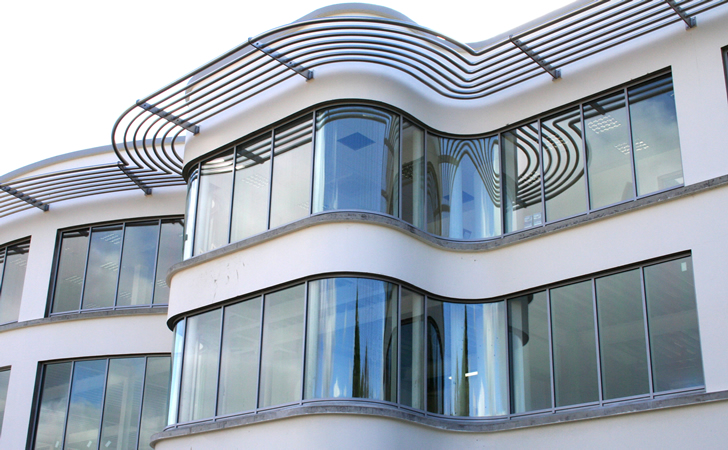Curved glass
Curved glass is commonly used as an element of façades and interiors in modernist designs for commercial and residential buildings. It often specified in designs as a feature element because of its uniqueness.
Technological advances in recent decades, such as robotic and automated manufacturing, have meant that curved glass has become easier and cheaper to produce and can be used to tighter radii, greater girths and greater overall dimensions.However, is not available in standard sizes so each building will require custom-made production.
Depending on the design requirements, there are a number of different forms in which curved glass can be used:
- Curved annealed glass: This is often used for showcasing purposes where there is less necessity for strength and safety, such as shop windows.
- Curved toughened glass: This is strong and shock-resistant, produced by heating annealed glass to 700°C and then cooling it rapidly. It is commonly used in staircases and for other interior purposes.
- Laminated glass: This is formed by bonding two layers of glass and is very tough. When it shatters it stays within the lamination, rather than breaking into shards.
Clearly communicating the requirements, criteria and expected standards early in the deign process can be important as then, all parties – glazing manufacturer, façade contractor, architect, client, and so on – can fully understand the implications of the requirement prior to manufacture.
The relevant standards for cylindrical bent float glass are BS ISO 11485 Part 2 (2012), and the American ASTM C 1464-06 (reapproved 2011).
[edit] Related articles on Designing Buildings Wiki
Featured articles and news
Professional practical experience for Architects in training
The long process to transform the nature of education and professional practical experience in the Architecture profession following recent reports.
A people-first approach to retrofit
Moving away from the destructive paradigm of fabric-first.
International Electrician Day, 10 June 2025
Celebrating the role of electrical engineers from André-Marie Amperè, today and for the future.
New guide for clients launched at Houses of Parliament
'There has never been a more important time for clients to step up and ...ask the right questions'
The impact of recycled slate tiles
Innovation across the decades.
EPC changes for existing buildings
Changes and their context as the new RdSAP methodology comes into use from 15 June.
Skills England publishes Sector skills needs assessments
Priority areas relating to the built environment highlighted and described in brief.
BSRIA HVAC Market Watch - May 2025 Edition
Heat Pump Market Outlook: Policy, Performance & Refrigerant Trends for 2025–2028.
Committing to EDI in construction with CIOB
Built Environment professional bodies deepen commitment to EDI with two new signatories: CIAT and CICES.
Government Grenfell progress report at a glance
Line by line recomendation overview, with links to more details.
An engaging and lively review of his professional life.
Sustainable heating for listed buildings
A problem that needs to be approached intelligently.
50th Golden anniversary ECA Edmundson apprentice award
Deadline for entries has been extended to Friday 27 June, so don't miss out!
CIAT at the London Festival of Architecture
Designing for Everyone: Breaking Barriers in Inclusive Architecture.
Mixed reactions to apprenticeship and skills reform 2025
A 'welcome shift' for some and a 'backwards step' for others.






















